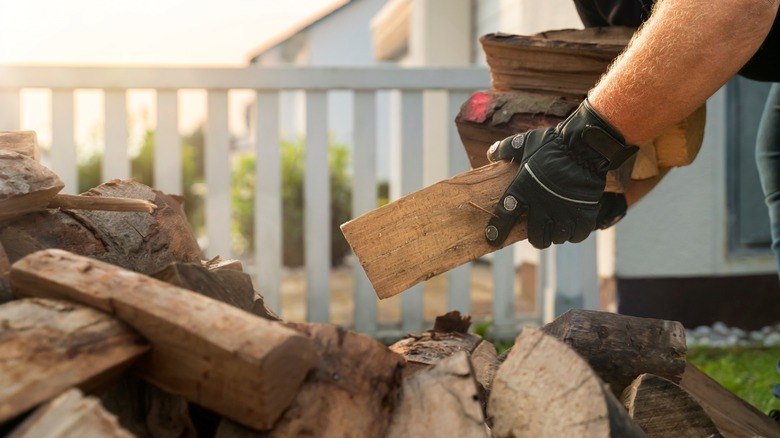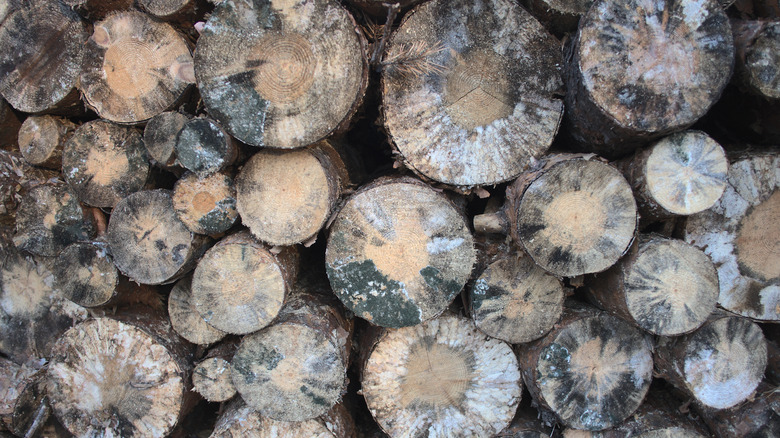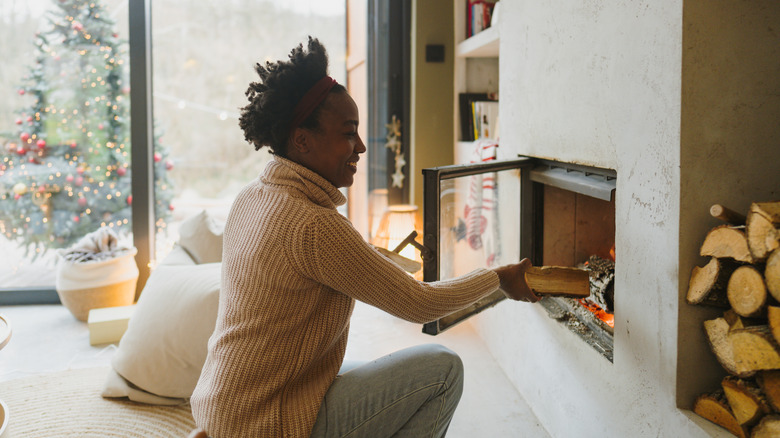Think Twice Before Burning Wood In Your Home Fireplace If You See This
As we enter the new year, we also sink deeper into the prime season for fireplace use, which typically lasts from fall until early spring. Annually gathering the firewood is a central responsibility of fireplace ownership, and this process should begin long before fireplace season. Professionals recommend collecting all of the firewood you need for the year no later than the summer before you intend to use it.
Whether you chop firewood yourself or purchase it pre-cut from a supplier, it's important to make sure that the wood you walk away with is not only healthy at the time of the purchase but will stay in good condition until you're ready to use it. This involves keeping the wood in a dry, well-ventilated place so the pieces can properly mature before burning. If the wood isn't left to mature under ideal environmental conditions, the outcome could be drastic. Avoid burning or storing wood inside a home fireplace that is covered in mold from improper care, as this can lead to serious health complications for the residents of the house — even more so for those with preexisting respiratory issues.
Although mold grows unrestricted in nature and is beneficial to the greater environment, this growth produces allergens that can incite allergic reactions when inhaled. Luckily, there are plenty of ways to practice mold prevention in your home to keep your family safe this winter.
How does firewood become moldy?
Mold develops on firewood in the same way it develops in other places around the house: It thrives in dark, damp areas where it can grow uninterrupted for extended periods of time. If your firewood has already started to show signs of molding, storing it in a moist space with little to no access to direct sunlight – like a basement or a garage– will only exacerbate the problem and accelerate the spread of mold and create an increasingly dangerous situation for you and your family.
Instead, homeowners should "season" their firewood for at least six months before use in order to ensure the wood is in good enough shape to burn safely throughout the fall and winter. To do this, store all firewood in a dry, open space with proper ventilation throughout your fireplace's off-season. Ideally, wood that's being seasoned should stay outside in an area where the pieces are exposed to the full sun throughout the day and receive protection during inclement weather. Possible methods of storage include a rack, a traditional woodshed, and a plastic tarp placed strategically on top of the heap to protect it from rain and snow without restricting its access to air. If your collected firewood is already damp from previous exposure to moisture, transport it to a sunny and windy spot outdoors and divide the logs into smaller pieces, which allows them to dry as quickly as possible. Placing the wood inside a room with a dehumidifier is an alternate solution.
What happens if you burn moldy firewood?
If the development of mold happens so commonly in nature, how much of a threat could it possibly pose? In all seriousness, it poses a pretty significant threat. Mold is composed of tiny, invisible particles called spores capable of reproducing and causing harm if ingested in large amounts. Mold spores can cause bouts of sneezing, coughing, headaches, difficulty breathing, and fatigue in humans upon making contact with respiratory organs. These particles can be especially troublesome for those with a history of asthma or allergy-related illnesses, as well as for those who are immune compromised, elderly, or too young to have developed a strong immune system, like infants. Mold spores are a cause for concern all by themselves, but the smell of mold and wet wood can also attract insects in search of food, like termites, which opens the door for pest extermination costs and other unsightly problems.
In some instances, firewood showing small amounts of mold can still be used and stored inside once the moldy wood pieces are removed and properly disposed of. This can be accomplished by brushing the mold off of the surface of the wood or by spraying warm water mixed with white vinegar along the affected areas. However, in some cases, firewood that has hosted the spread of mold for more than 48 hours might be rendered unsalvageable, as it's too risky to expose your home's residents to high levels of mold.


